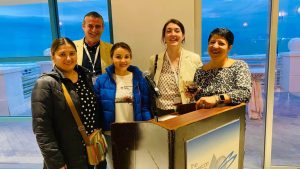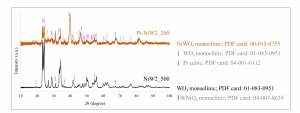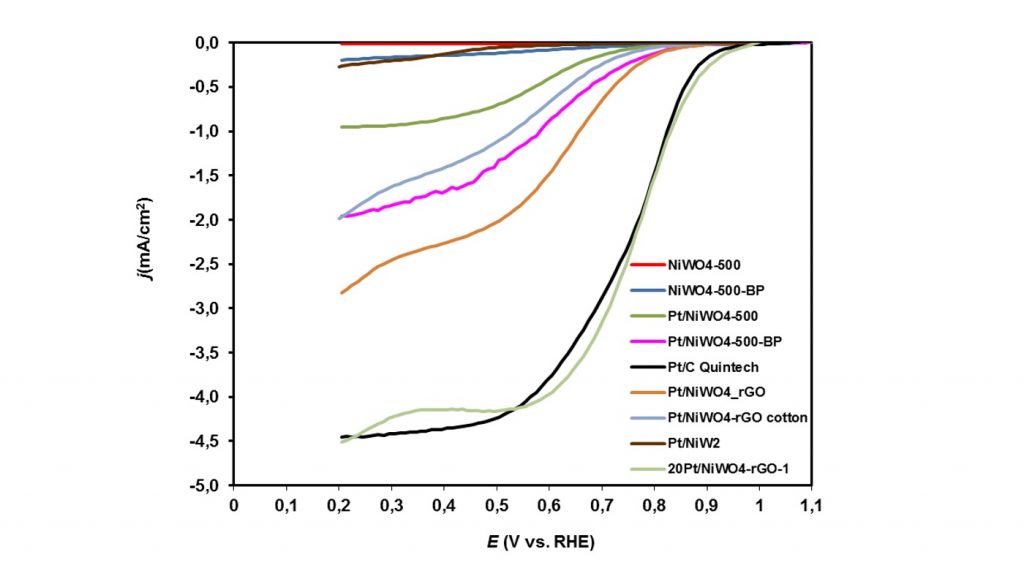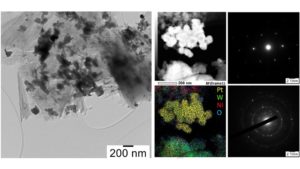Holistic design of fuel cell electrocatalysts for the least power applications
Project Director: Dr. Mihaela FLOREA

The CATALEAST proposal allows bringing together diverse backgrounds of the partners and creating a
synergy between self-experiences to be applied to new fields of modern catalysis and fuel cells. The project
will certainly bring an effective added value to the sustainable development for all partners. This experience
might be a key for further common actions between all partners, and also it will give the opportunity for
the young researchers to complete their qualifications working on this subject. Instrumental techniques at
the Romanian (P2, P3) and Spanish (P4) partners could become available to the Hungarian partner (P1)
for catalyst characterization. The Spanish partner (P4) would have a new type of catalysts for MEA
construction, which would be provided by the Hungarian (P1) and Romanian (P2) partners. Both the
Spanish (P4) and Romanian (P2, P3) partners could acquire knowledge on the field of high throughput
techniques and combinatorial methods used by the Hungarian partner (P1), which is particularly useful in
the research of material science with a large number of samples. Since both the Hungarian (P1) and the
Romanian partners (P2) are able to reach only the synthesis of the electrocatalysts of the fuel cells, the
Spanish (P4) expertise gives them the opportunity to compile MEA and produce micro fuel cells from the
novel materials. Thus, through transnational cooperation, research results can be brought closer to practical
implementation.
Role in the project: Partner P3 (National Institute of Materials Physics) will be responsible for the physicochemical characterization of the most promising ORR and HOR catalysts as an input coming from the high throughput electrochemical screening performed by the P1.
Relevant expertise: The team’s competences are in the field of chemistry, catalysis and materials physics. As presented in the Annex 1 the team possesses expertise in the field of thematic area as well in the field of the project.
Added value: A deep understanding through characterization of the new materials; recommendation of ways to make the materials more competitive.
Leader: Mihaela Florea, specialized in material synthesis and surface characterization, in charge with the management and dissemination tasks
Members:
Florentina Neatu, PhD, specialist in material synthesis, good experience working with characterization techniques; dissemination
Stefan Neatu, PhD, with competence in materials synthesis and characterization.
Lucia Leonat, PhD, in charge with electron microscopy studies characterization, dissemination.
Mihaela M. Trandafir, post-doc, in charge with SEM characterization, dissemination.
Iulia M. Chirica, PhD student, in charge with RAMAN and UV-vis characterization, dissemination.

Team members at 44th ICACC Conference 2020
FIRST STAGE 2019
During the first stage of the project, over 10 samples were prepared using different preparation methods. It has been observed that the preparation method influences the type of crystalline phase present in the final material. Also, the amount of dopant influences the crystallinity of the sample, so that with increasing the amount of dopant the crystallinity decreases, as presented in Figure 1:

Figura 1. X-ray diffractograms of Ni based samples prepared by different methods
SECOND STAGE 2020
According to the working plan, in this stage we envisaged the detailed physico-chemical characterization of the materials prepared by P1. The materials are Ni-W based mixed oxide modified with graphenes, loaded with different amount of Pt, Pd or/and Ru. The best composition was scaled up successfully to 1g at laboratory level. Also individual cells were characterized after electrochemical testing.
The most electroactive materials in ORR contain Pt (20%) and a mixture of Ni- W oxides with rGO. This material is as active in ORR as teh commercial Pt/C but much more stabel. In Figure 2, are represented the ORR curve of a series of catalysts for comparison.

Figure 2. ORR curves of a series of materials based on Ni-W oxides.
THIRD STAGE 2021
During this stage, scale-up of the preparation of the best composition was realised. P1 and P2 were in charge of this task. Scale-up included scientific issues related to catalyst preparation at large scale, commercial issues such as the supply, cost and quality of raw materials and HSE (Health/ Safety/ Environment) issues.
In order to get information of the success of the scale-up procedure, the complete compositional/structural characterisation of several samples was done on the scaled-up anodes and cathodes materials by P2 and P3 partners.
In order to get information on the behaviour of the scaled-up catalysts under reaction conditions, the test in a PEMFC will be done by a Spanish partner (CIEMAT).

Figure 3. TEM images of Pt supported on NiWO4-GNP
FOURTH STAGE 2022
Within this stage, the following tasks were achieved:
i) optimization of the compositions of the new generation of catalysts for testing in the portable fuel cell. The assembly of the individual cells and the portable application were made in collaboration with our partners from Ciemat, Spain, Madrid. For optimization, the two most promising catalysts identified in the previous stages of the project were chosen, namely:20%Pt/25 wt.%Ti0.8Mo0.2O2-75 wt.% BP for anode and 40%Pt/75wt.%Ti0.93Nb0.07O2-25 wt.% BP for cathode, prepared at 10 g each batch in the previous stages.
ii) testing of the electrodes - for this commercial gas diffusion electrodes are used in the cathode and in anode FCETC (0.30mgPt/cm2 Pt/C 40%, on carbon cloth). The electrolyte membrane is Nafion NR 212 (Ion Power Inc.), and double serpentine flow field plates (Au coated stainless steel) are used (see Figure 4). The active area of the cell in 15.2 cm2.

Figura 4. Pictures of the standard cell assembly.
Participation in a project, CHEMPOET, aiming at spreading science, especially chemistry in high schools.
More information can be found on http://chempoet.mariusmatache.ro
Participation in CHIMIE360 project - Interactive presentations in high schools on the applicability of chemistry and its implications in everyday life.
1. Articles
- “Undoped SnO2 as Support for Ni Species to Boost the Oxygen Generation through Alkaline Water Electrolysis”, ACS Appl. Materials & Interfaces 2020, 12, 18407–18420; DOI: 10.1021/acsami.9b19541 (IF=9,220)
- “VAlPOs as Efficient Catalysts for Glycerol Conversion to Methanol”, Gheorghita Mitran, Florentina Neatu, Stefan Neatu, Mihaela M. Trandafir, Mihaela Florea, Catalysts, 10(7) (2020) 728; DOI:10.3390/catal10070728 (IF=3,520)
- “Highly Efficient Ultralow Pd Loading Supported on MAX Phases for Chemoselective Hydrogenation”, M.M. Trandafir, F. Neatu, I. M. Chirica, S. Neatu, A. C. Kuncser, E. I Cucolea, V. Natu, M. W. Barsoum, M. Florea, ACS Catalysis, 2020 (10) 728; DOI: 10.3390/catal10070728. (IF=13,084)
- "CuWO4 with CuO and Cu(OH)2 native surface layers", S. Somacescu, Adelina Stanoiu, I. V. Dinu, J. M.-Calderon Moreno, O. G. Florea, M. Florea, P. Osiceanu, C. E. Simion, Materials, 2021, 14(2), pp. 1–18, 465, DOI: 10.3390/ma14020465 (IF=3,620)
- "NiO / Sr doped Ce0.85Pr0.10 Er0.05O2-δ mesoarchitectured catalyst for partial oxidation of CH4 and IT-SOFC anode fueled by H2", L. Navarrete; M. Florea; P. Osiceanu; J. M. Calderon Moreno; M. M. Trandafir; S. Somacescu; J. M. Serra, Microporous and Mesoporous Materials, 2021 (323) 111171, DOI: 10.1016/j.micromeso.2021.111171 (IF=5.45)
- "Recent progress in electrocatalysts and electrodes for portable fuel cells", Neaţu, Ş., Neaţu, F., Chirica, I.M., Borbath I., Talas E., Tompos A., Somacescu S., Osiceanu P., Folgado M.A., Chaparro, A.M., Florea, M. Journal of Materials Chemistry A, 2021, 9(32), pp. 17065–17128, DOI: 10.1039/d1ta03644k (IF=12.73)
- "Synthesis and Characterization of Graphite Oxide Derived TiO2‐Carbon Composites as Potential Electrocatalyst Supports", Ilgar Ayyubov, Irina Borbáth, Zoltán Pászti, Zoltán Sebestyén, Judith Mihály, Tamás Szabó, Erzsébet Illés, Attila Domján, Mihaela Florea, Dana Radu, Andrei Kuncser, András Tompos, Emília Tálas, Topics in Catalysis, 2021, DOI: 10.1007/s11244-021-01513-1 (IF=2.80)
- "Electrocatalytic properties of mixed oxide containing composite supported platinum for polymer electrolyte membrane (PEM) fuel cells", Ilgar Ayyubov, Emília Tálas, Khirdakhanim Salmanzade, Andrei Kuncser, Zoltán Pászti, Ștefan Neațu, Anca G. Mirea, Mihaela Florea, András Tompos, Irina Borbáth, Materials, 2022, 15, 3671 doi.org/10.3390/ma15103671
- "Design of electrocatalysts with reduced Pt content supported on mesoporous NiWO4 and NiWO4-graphene nanoplatelets composite for oxygen reduction and hydrogen oxidation in acidic medium", Simona Somacescu, Petre Osiceanu, Jose Maria Calderon Moreno, Daniela C. Culita, Florentina Neațu, Mihaela M. Trandafir, Ștefan Neațu, Andrei Kuncser, Gábor P. Szijjártó, Emília Tálas, András Tompos, Irina Borbáth, Mihaela Florea, Journal of Hydrogen Energy, 2022, in press, doi.org/10.1016/j.ijhydene.2022.04.270.
2. Articles in progress:
- "Impact of the Pt loading and deposition method on NiWO4 – GNP composite over electrochemical activity in ORR and HOR", Florentina Neațu, Mihaela M. Trandafir, Ștefan Neațu, Andrei Kuncser, Gábor P. Szijjártó, Simona Somacescu, Petre Osiceanu, Jose Maria Calderon Moreno, Emília Tálas, András Tompos, Irina Borbáth, Mihaela Florea, in preparation
- "Design of Ti–Sn mixed oxide–carbon composite supports for Pt-based electrocatalysts for polymer electrolyte membrane fuel cells: peculiarities of preparation", Irina Borbáth, Khirdakhanim Salmanzade, Emília Tálas, Zoltán Pászti, Cristina Silva, István E. Sajó, Stefan Neatu, Andrei Kuncser, Dana Radu, Mihaela Florea, András Tompos, to be submitted to Catalysis Today, 2022
2. Conferences:
- “Revealing the catalytic features of MAX phase, Novel applications and device fabrication (electrochemical energy storage, biosensors, etc.) of MAX/MAB phases and Mxenes”, ICACC 2020, Daytona, Florida, SUA, Ianuarie 2020 – Oral presentation;
- “Cost efficient oxygen generation through alkaline water electrolysis using Ni on SnO2mesoporous support-based electrocatalysts”, ICACC 2020, Daytona, Florida, SUA, Ianuarie 2020 – Oral presentation;
- “Mesoporous Pt/NiWO4-BP Bifunctional Electrocatalyst for hydrogen oxidation and oxygen reduction reactions”, 23rdInternational Conference „New Cryogenic and Isotope Technologies for Energy and Environment”, May 25-27, 2020, Băile Govora, România.-canceled
- Electrocatalysts based on tungstenate frameworks for Polymer Electrolyte Membane Fuel Cells (PEMFCs), S. Somacescu*, Florea, J. M. Calderon Moreno, P. Osiceanu1, I. Dascalu, F. Neatu, S. Neatu, M. M. Trandafir, I. Borbath, E. Talas and A.Tompos, Invited - oral presentation, November 2020, a-XII-a ediție a Simpozionului Național de Chimie „Contributions to Increasing the Quality of Education and Research in the Field of Chemistry”
- Investigation of synergistic behaviour of Ni species and bimodal mesoporous SnO2 in oxygen evolution reaction, Mihaela Florea, Invited - oral presentation, November 2020, Craiova, Romania, XIIth edition of the National Chemistry Symposium „Contributions to Increasing the Quality of Education and Research in the Field of Chemistry”
- “The use of mesoporous NiWO4, Pt/NiWO4and their composites with graphene nanoplatelets as bifunctional electrocatalysts for ORR and HOR", 45th International Conference and Exposition on Advanced Ceramics (ICACC 2021), February 8 - 12, 2021 –Oral presentation
- “NiWO4, Pt/NiWO4 and their composites with graphene nanoplatelets as bifunctional electrocatalysts for ORR and HOR", Catalysis Science & Technology 10th Anniversary symposium 2021, November 16 - 17, 2021 – poster presentation
- Design of Ti–Sn mixed oxide–carbon composite supports for Pt-based electrocatalysts for polymer electrolyte membrane fuel cells: peculiarities of preparation, Irina Borbáth, Khirdakhanim Salmanzade, Emília Tálas, Zoltán Pászti, Cristina Silva, István E. Sajó, Stefan Neatu, Andrei Kuncser, Dana Radu, Mihaela Florea, András Tompos, RomCAT2022, The 13th International Symposium of the Romanian Catalysis Society, Iunie 2022, Garbova ROMANIA- Oral presentation
Mihaela Florea
mihaela.florea@infim.ro
PROJECTS/ INTERNATIONAL PROJECTS
Copyright © 2025 National Institute of Materials Physics. All Rights Reserved